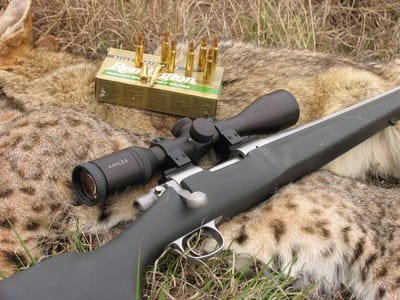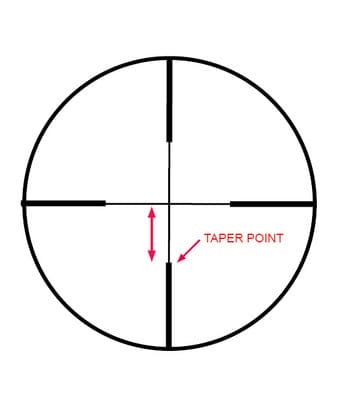
Ballistic reticles have become all the rage. In some ways this is a good thing because it helps hunters hit at longer distances. It can be a bad thing if it inspires hunters to shoot beyond a range where they are capable of hitting, especially if doing so without prior certification their reticle is actually telling them exactly where their bullet will hit. I have worked with most of the ballistic reticles available and have yet to find one that does not work. The trick is spending time on the practice range to obtain the proper zero and validate additional aiming points.
Ballistic reticles work because of something called subtension. A reticle’s subtension is the distance that a span of that reticle covers at a certain range. As the range to the target increases so does the subtension of the reticle. For example, if your bullet drops 30 inches at 300 yards, to hold dead on and hit at that range, you need a secondary aiming point below the primary aiming point, which subtends to 30 inches at 300 yards. This subtension would equal 10 inches at 100 yards. What a lot of hunters do not understand is that because of this, a standard duplex reticle in a variable powered riflescope can be used just like a ballistic reticle.
By adjusting the magnification on variable scopes with second focal plane reticles, you can tune the reticle to work with just about any rifle/load combination. You just need to understand the math. Let’s say you are using a 3-9X riflescope and the space between where the horizontal and vertical wires intersect and the point along the bottom vertical wire where it thins has a subtension of nine inches at 100 yards and 27 inches at 300 yards. You can tune this subtension to equal 30 inches at 300 yards by adjusting the scope’s magnification.
Just use the following formula: Current Magnification/(Desired Subtension/Current Subtension) = New Magnification
If we apply the formula to the problem above it would look like this: 9/(30/27) = 8.10. This means if you set the magnification to 8.1X the point along the bottom vertical wire where the wire thins will subtend to 30 inches at 300 yards.

Now let’s assume your bullet also drops 48 inches at 400 yards. When the scope is set to 9X the same subtension will equal 36 inches at 400 yards so we again use the formula to determine the scope should be set to a magnification of 6.76X to make this subtension equal 48 inches at 400 yards. In either case, you aim with the taper point of the bottom vertical wire as opposed to the point where the vertical and horizontal wires cross.
If you do the math you need to go to the range to verify that your bullet’s trajectory is indeed as you suspected and that your magnification settings for 300 and 400 yards are correct. The alternate method is to skip the math and sight your rifle in at 100, 150 or 200 yards, whichever you prefer, and then shoot a group at 300 yards. Mark this group with a spot you can see from the bench and while holding the rifle still with the common aiming point held on the same spot you aimed at when shooting the group, adjust the magnification until the taper point moves to the spot where your group is. After you do this you will need to shoot a confirmation group using the taper point as the aiming point to make sure you have the correct magnification setting. Repeat this exercise at 350, 400, and 450 yards or at whatever distance you want, recording the correct magnification setting at each range.
When hunting all you will need to do is determine the distance to the animal, set the riflescope to the correct magnification and then hold dead on using the taper point as an aiming point. This works just as good as a ballistic reticle but takes an extra second or so to apply. It will work with most duplex style reticles with the exception of those that have an extremely wide opening or large subtension between the common aiming point and the taper point. It can also be used to precisely “tune” ballistic reticles to your load.
Of course you can always opt for one of the fancy new ballistic reticles like the ones available from the T.K. Lee Company. They will install dots on your reticle that represent bullet drop at whatever distances you desire. The Leupold custom shop offers a similar service for their scopes. Regardless, always go to the range before hunting and verify that your aiming points are indeed pointing to the spot your bullets will land.
Contact:
Leupold; www.leupold.com; 800-538-7653
TK Lee; www.scopedot.com; 205-913-5222



